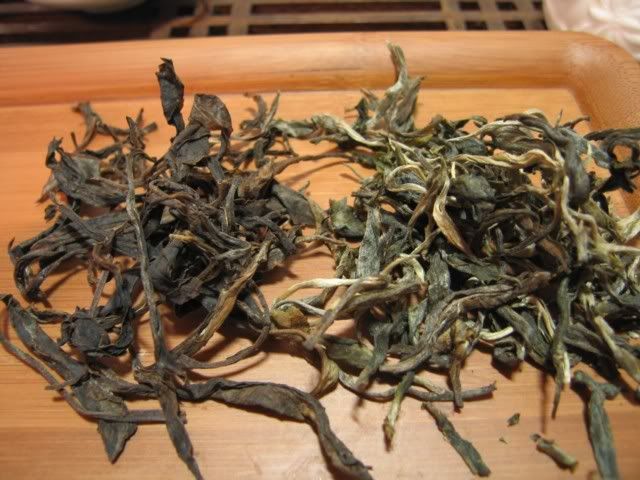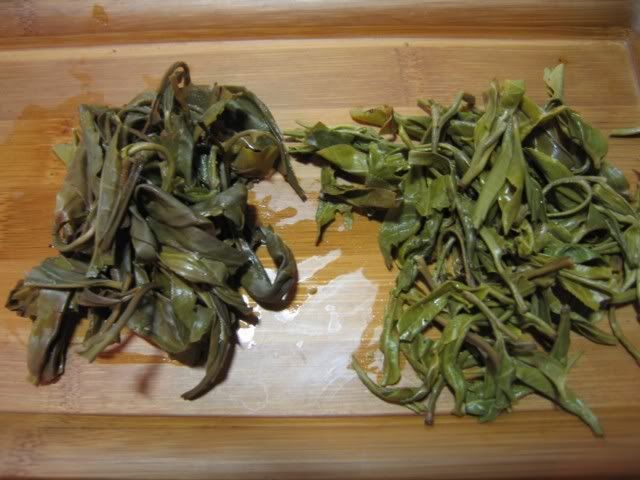When you have a lot of samples, you have a lot of leftovers. Sometimes I have the presence of mind to use up all the samples, but sometimes I don’t. So, I have a few of these “odds and ends” samples that really isn’t enough for a session on their own, but just enough to throw away. This is what Chinese call “chicken ribs” — “tasteless for eating, but lamentable to throw away”. (There’s a long story for this, from the Romance of the Three Kingdoms.)
So today I decided to dispose of two of these samples by mixing them together and drinking it. One is a leftover Yiwu from a long time ago. The other is the supposedly Lao Banzhang. I had a bit more of the Lao Banzhang than the Yiwu, but they add up to about 6g of tea. You can see how different they look

I think the Yiwu is 2005, and the Banzhang is new — this spring’s pick.
So I mixed them up… and stuffed them into the gaiwan

And out came the tea

The taste is a little interesting. There’s the up front bitterness and strength of the Banzhang, and then the sweetness of the Yiwu appears. Except something’s not quite right. A few infusions later…. yup…. the Banzhang is, as I had suspected, a green tea. Last time I wasn’t sure partly because it was so fresh off the mountain. I thought perhaps it is a product of its extreme young age. Now, almost two months later, it’s still tasting like that… in fact a little worse… and I start getting suspicious. The bitterness is the kind that doesn’t go away. It’s quite an uncomfortable feeling, drinking the tea. You can see the mixture of the leaves in this

The body of the tea is good, but I think the greeness of the Banzhang killed it. Would’ve been more interesting if it were a properly processed tea… which it isn’t.
I eventually picked out all the Banzhang leaves (it’s not very hard to do). I then brewed the Yiwu more or less just on its own, with maybe a few of the Banzhang leaves in there. Much better, with a solid sweetness that one would expect from the Yiwu.
This made me realize two things
1) If mixing two teas together, the sweeter/lighter one should probably account for more of the blend in order to show its flavour. Otherwise, the more up front/obvious tea will overpower it.
2) In small enough quantities, oven-dried green tea is not noticeable as long as you have enough real puerh to cover it up.
1 is not a bad thing to know, 2 is a little unsettling, unfortunately.

Here are the two piles of leaves, wet. You can see how they look very different… and how the Banzhang looks just a little too green. Smelling the wet leaves, it has that classic Yunnan green tea smell. No good. My friend got gibbed buying this in Yunnan (this is a tea they didn’t pick themselves).

2 responses so far ↓
lewperin // June 5, 2007 at 2:34 pm |
That picture with the Banzhang green leaves separated out is fascinating. But it could lull some people into a false sense that green teas are easier to distinguish from proper sheng Pu’er than they really are. As I’m sure you know, there are lots of Chinese green teas whose spent leaves are nowhere as vivid a green as your Banzhang.
MarshalN // June 5, 2007 at 11:23 pm |
Indeed, this Banzhang is a very vivid, fresh green. Most green teas are a bit duller than that.
But it’s the taste and the smell that tell me that this is a green, not the colour — colour is a pretty poor indicator, as you’ve noted.